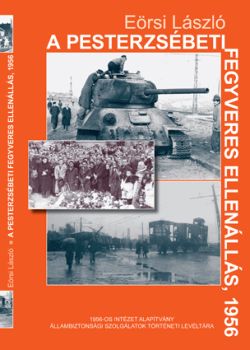László Eörsi: Armed resistance in Pesterzsébet, 1956
Budapest: 1956-os Intézet Alapítvány-Állambiztonsági Szolgálatok Történeti Levéltára, 2015, 231 p.
 |
SUMMARY
This volume explores the history of Pesterzsebet in 1956. Pesterzsebet is a southern suburb of Budapest, which played a significant role during the 1956 Hungarian Revolution. Its citizens opposed the Soviet forces and their Hungarian allies as early as the very first days of the revolution, and they conquered the city's most important public buildings. During the last days of October, the local community took their fate into their own hands and began to organize themselves in a democratic manner. The local civilians joined forces with those soldiers and police officers who agreed with the goals and ambitions of the revolution. Additionally, these forces aimed to capture the perpetrators of the previous Stalinist regime, so as to ensure that they answer for their crimes before an independent court. In the meantime, the organizations of the revolution took over the administration, they issued newspapers and had their own radio.
On November 4th, 1956, the day of the Soviet intervention, one of the bloodiest battles was waged at Juta Hill, on the border of the district. The fighting resulted in many Soviet and allied casualties. In the following days, it was here, at the Határ Street, Nagykőrösi Street and elswhere, where the revolution continued until the latest in the capital, up until November 11th, when the Soviets conquered this district as well.
The soldiers who were deployed to this area tirelessly assisted the armed civilians in this district, both in numbers and weapons. However, this scholarly volume focuses not on them, but on the contribution and the story of the armed civilians, who fought against the Stalinist regime how from the very beginning of the revolution.
The persecution following the repressed revolution was merciless. The largest court case, involving 5z fighters, relates to the battles of Juta Hill. This included II death sentences and out of them seven soldiers were, in fact, executed. Two armed civilians from Pesterzsébet were also executed and many were sentenced to life imprisonment, which resulted in the end in 15 years in prison.
This scholarly volume incorporates interviews, biographies, bibliographic notes, a glossary of names, several tables and other illustrations.

